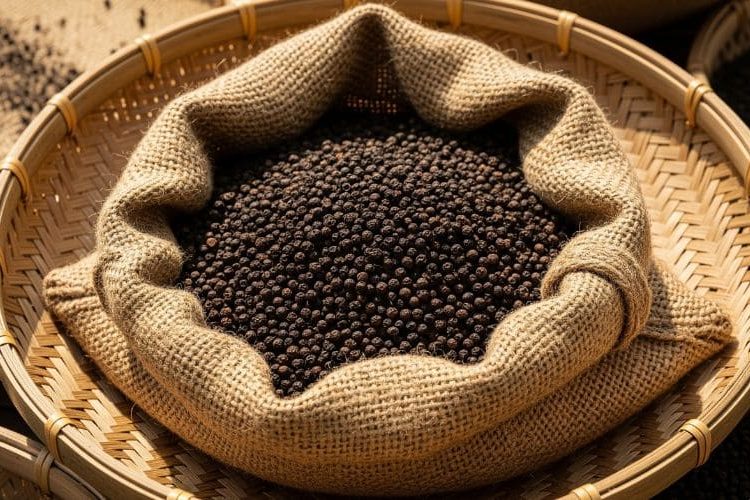Vietnam pepper has been widely established globally — not just for its fiery, spicy flavor and rich aroma, but for its reliable and stable quality as well. It is for this reason that Vietnam is still a favored supplier to several demanding markets, including the U.S. and key European countries.
So, how to import pepper from Vietnam smoothly and without hassle? Here in this guide, we’re going to present to you how to access safe suppliers in Vietnam. We will also outline the major benefits and pitfalls of importing pepper from this country. This will allow you to make a well-informed decision for your company.
Vietnam’s Pepper Industry at a Glance
For more than two decades, Vietnamese pepper has led the world in both production and export. The country currently accounts for around 40% of global pepper output and 60% of total exports worldwide.
In Q1 2025 alone, Vietnam exported a combined quantity of more than 47,600 tons of pepper, of which more than 39,800 tons was black pepper and 7,800 tons was white pepper. Turnover in exports amounted to USD 326.6 million, an increase of nearly 39% compared to the same period in 2024.
Today, Vietnamese pepper is shipped to over 120 countries, the biggest importer currently being the U.S. During Q1 2025. India, Germany, the UAE, and China are also among the biggest destinations.
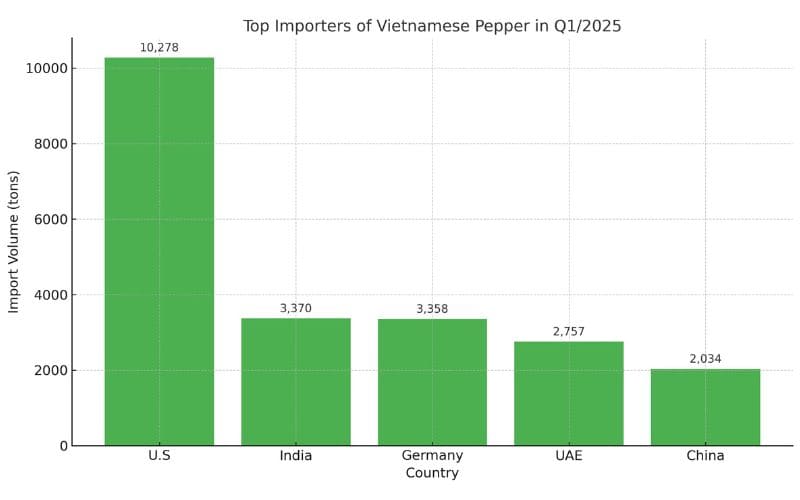
Types of Vietnamese Pepper Products Available for Export
Black pepper and white pepper (both in whole and powdered form) are the two main items under Vietnam’s export hierarchy of pepper. In 2024, Vietnam exported 250,600 tons of pepper. Among this, black pepper accounted for approximately 220,269 tons (around 90%), and white pepper comprised around 30,331 tons.
1. Black Pepper
Black pepper is harvested when the pepper berries are ready — usually when some of the lower clusters have begun to redden. Berries are sun-dried for about 10 days after harvest. They darken slowly over this time.
- Flavor: Very strong, warm, and spicy, but not very sharp. The heat comes on slowly, with a pleasant warming sensation.
- Usage: Regularly used in cooking, especially in meat marinades and sauces.
- Popular importers: United States, India, Germany, and United Arab Emirates.
- Key exported product: Chu Se pepper (known for its strong aroma, spicy heat, large grain size, and consistent quality) and Vinh Linh pepper (identified by: large, glossy pepper spikes, evenly-sized, clean berries with minimal defects).
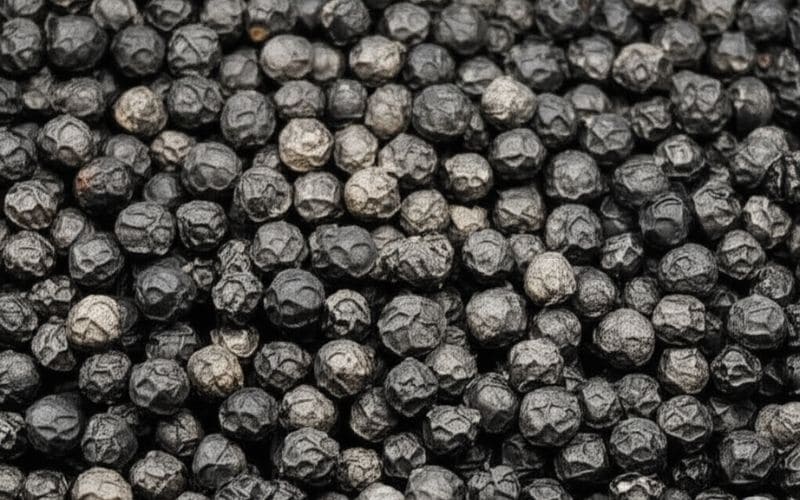
2. White Pepper (also referred to as Skull Pepper)
White pepper is the interior of black pepper. It is manufactured from completely ripe red pepper berries. The berries are soaked in water for about 10–12 days to soften the outer skin. Farmers peel the outer shell after soaking, with the white seed remaining, normally known as the “skull.” The seeds are dried in the sun or by machines to remove any moisture content.
- Flavor: More pungent than black pepper. The pungency is faster and more intense.
- Usage: Often applied in pale-colored sauces or where you desire a lot of aroma without desiring to alter the appearance or color of the food.
- Popular importers: Germany, the Netherlands, Japan, and South Korea.
- Key exported product: White pepper of Chu Se or Vinh Linh varieties.
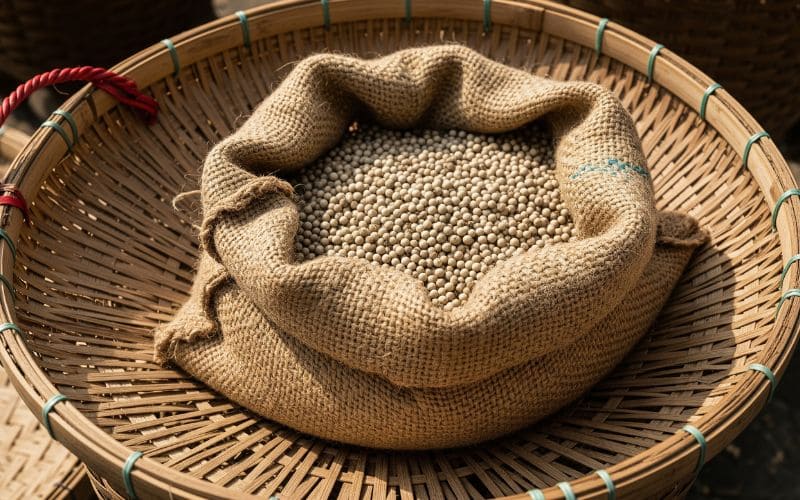
Cost of Sourcing Popular Vietnamese Pepper Products
The table below gives you a clear picture of each type of pepper product, along with key features, MOQs, and approximate FOB prices. This will help you make better purchase decisions:
| # | Type of Product | Key Characteristics | MOQ (Estimated) | Estimated FOB Price |
| 1 | Whole Black Pepper – EU Compliant | Dried, for cooking | 1 ton or more | $1,800-$2,110/ton |
| 2 | Whole Black Pepper from Binh Phuoc | Sun-dried, 24-month shelf life, suitable for boiling | 13 tons | $4,000–$5,000/ton |
| 3 | Black Pepper Powder | Brown, ready to eat and for food processing | 1,000 kilograms | $2.80–$4.00/kg |
| 4 | Whole White Pepper | Max 12.5% moisture, less than 0.2% foreign matter | 13 tons or more | $4,500–$5,000/ton |
| 5 | White Pepper Powder | 24-month shelf life, for cooking and seasoning | 25 tons or more | $6,900/ton |
| 6 | Whole Red Pepper | From An Giang Province, dried, blended | 6,000 kilograms | $10–$14/kg |
| 7 | Freeze-Dried Green Pepper | Intense flavor, farm fresh | 50 kilograms or more | $2.00-$3.00/kg |
Note: Vietnamese pepper’s import price may also fluctuate with grade, supplier MOQ, as well as production location.
Vietnam pepper grades explained: Each type of Vietnamese pepper is present in different grades, mostly differentiated by density (in grams per liter – g/L) and processing type (black or white pepper). Increased density typically points to higher quality overall.
- Black pepper common grades: 500G/L, 550G/L, 570G/L, 580G/L. For instance, 500G/L black pepper typically has a weight of 500 grams per liter, moisture no higher than 13% and impurities less than 0.5%.
- Typical White Pepper grade: 630G/L
Key Advantages When Sourcing Vietnamese Pepper
According to the Vietnam Pepper and Spice Association (VPSA), despite the effect of climate change on pepper crops in the majority of the world, Vietnam pepper export quality is highly sought after for its fiery aromatic odor and sharp flavor.
Below are some of the main reasons why international buyers continue to prefer pepper from Vietnam over other origins:
1. Strong and Stable Supply All Year Round
As mentioned earlier, Vietnam accounts for nearly 60% of global exports. This makes it the top pepper supplier in the world. Even during the challenging COVID-19 period, Vietnam maintained strong production year after year — often much higher than its two main competitors, Brazil and Indonesia.
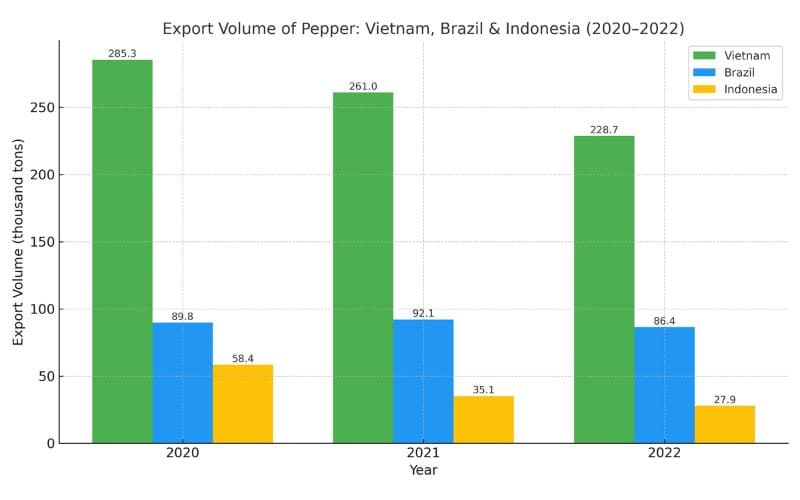
What supports this stability is Vietnam’s well-developed supply ecosystem. Vietnam has around 200 processing and exporting companies, including 15 major exporters whose factories are internationally compliant with such standards as ASTA, ESA, and JSSA.
Large farming areas in Gia Lai, Dak Lak, Dak Nong, and Binh Phuoc also contribute to this strength. These regions have a tropical climate with average temperatures between 20°C and 30°C, which is ideal for growing high-quality pepper.
2. A Wide Range of Pepper Types
Vietnam doesn’t just grow different pepper varieties; it also offers a diverse range of pepper types and quality grades based on density (g/l), moisture levels, and impurity content.
In addition, the market also includes special products such as
- Organic pepper
- Steam-sterilized pepper
- Naturally sun-dried pepper
Buyers can also customize orders based on specific needs — such as mesh size, moisture level, and packaging options. This flexibility helps them tailor their sourcing for different target markets or supply chains, including retail and food.
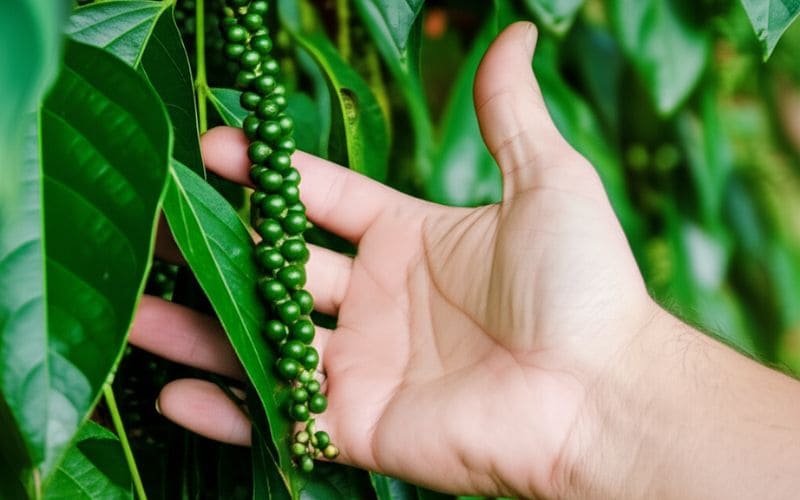
What Makes Vietnam Pepper Sourcing Challenging?
Even though Vietnam is now the world’s largest pepper supplier, international buyers may still face a few challenges when sourcing from this market. Some of the most common issues are:
1. Price Volatility
Like many countries, Vietnam has been affected by global inflation and geopolitical tensions, which can disrupt export activities — including the pepper trade. According to the Vietnam Department of Import and Export, global pepper prices are expected to remain unstable due to unpredictable changes in market demand.
2. Inconsistent Product Quality
The Vietnamese pepper industry still faces some big challenges. One of the biggest is the lack of close coordination between farmers, scientists, and businesses in the production chain.
The use of organic fertilizers, proper harvesting techniques, and standardized post-harvest handling are not yet consistent across the country. As a result, product quality can vary significantly between different growing regions.
Where Is Pepper Grown and Exported From in Vietnam
Vietnam currently has around 110,500 hectares of pepper cultivation. About 95% of this area is located in the Southeast and Central Highlands regions. The rest is spread across the North Central and South Central Coast areas.
If you’re wondering where to source pepper in Vietnam, these regions below are a great starting point:
1. Tay Nguyen (Dak Lak, Dak Nong, Gia Lai)
Tay Nguyen, or the Central Highlands, is the largest pepper-growing region in Vietnam, with 82,865 hectares, accounting for over 61% of the country’s total output.
Farmers here are applying sustainable farming models that meet international standards such as GlobalG.A.P and Rainforest Alliance. They also use modern techniques to ensure better quality—for example:
- Pepper berries are harvested at 5–10% ripeness uniformity.
- Post-harvest moisture is kept at an ideal level of 11–12%.
One of the region’s most famous products is Chu Se pepper. And another common variety grown here is “tieu trau” (buffalo pepper), which is easy to recognize by its purple buds and large, spicy black berries with a greenish shine.
2. Southeast Vietnam (Binh Phuoc and Ba Ria – Vung Tau)
The Southeast is Vietnam’s second-largest pepper-growing region, with about 38,000 hectares under cultivation. This accounts for roughly 30% of the country’s total pepper-growing area.
Binh Phuoc is often referred to as the “pepper capital” of the region, with an average yield of 2.1 tons per hectare (in 2024). Its signature product is Loc Ninh pepper, known for:
- Strong resistance to disease
- Firm, round berries with thick skins
- A deep, lingering spicy flavor
In Ba Ria – Vung Tau, the 2025 crop year recorded over 10,370 hectares of pepper, with nearly 10,000 hectares currently in harvest. The black pepper from this area is known for
- Large berry size (up to 5.8 mm in diameter)
- Thin skin (only 92.7–157.7 µm)
- A mild, pleasant spiciness
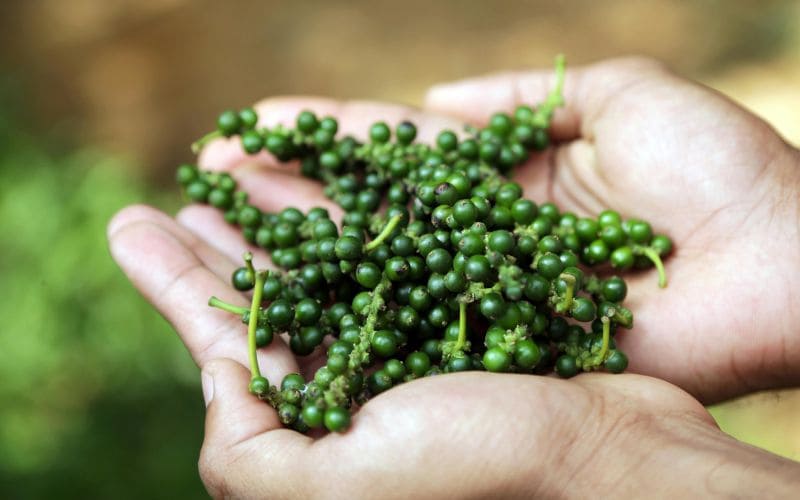
3. Quang Tri Province (North Central Coast)
Although smaller in scale (it has just around 2,200 hectares of pepper in 2024), Quang Tri is one of the leading regions in organic and sustainable farming. For nearly a decade, most farmers here have shifted to international-standard farming models, including EC 134 (Europe), USDA Organic (USA), and JAS (Japan).
The region is best known for Vinh Linh black pepper, which is among the Vietnamese peppers exported to the U.S. and is now expanding into Europe.
Key Things to Finalize Before Sourcing Pepper From Vietnam
Before you close any deal for Vietnamese pepper, make sure to check the following:
- Confirm the quality standards based on your target market’s specific requirements. For example, ASTA standards in the U.S require clean, odor-free pepper with moisture below 13.5% and limited foreign matter.
- Understand import regulations in your country for dried agricultural goods. Know the required documents, such as Certificate of Origin (CO), Phytosanitary Certificate, Commercial Invoice, Packing List, and Bill of Lading (B/L).
- Mutually agree on payment terms that are safe and reasonable to both parties, say, a 30% deposit based on the total order value. Most Vietnamese pepper suppliers prefer T/T (Telegraphic Transfer), which is a bank-to-bank wire transfer via the SWIFT system.
- Request a physical sample before placing a bulk order to verify real product quality, including consistency, moisture level, and flavor of the pepper.
Where to Source Verified Vietnam Pepper Suppliers
There are two main ways to find certified Vietnam pepper suppliers:
1. Offline
Vietnam organizes regular agricultural expos and trade fairs that always have pepper as a featured product. Such expos are the perfect time to:
- Inspect hundreds of in-person exporters and farmer cooperatives from top-producing regions like the Central Highlands, Southeast Vietnam, and Quang Tri.
- See and check pepper samples on the spot — including aroma, color, size, and more.
- Directly negotiate to find out the export capacity of the supplier, prices, MOQ, certifications, and so on.
Some key trade shows worth attending are AgroViet – International Agricultural Fair (November in Hanoi, usually) and Vietnam Foodexpo (takes place mid-November every year in Ho Chi Minh City).
2. Online
These days, finding a reliable pepper supplier in Vietnam doesn’t require a physical visit. You can start your search online through Google, B2B platforms, or international sourcing agents.
Among such options, VinaSources is a standout choice if you’re looking to source authentic Vietnamese pepper. Being the one-stop B2B sourcing platform, we bridge global buyers with reliable Vietnamese suppliers, notably in agriculture, food, spices, and raw materials. Beyond connecting you to sellers, VinaSources manages the whole process of sourcing from A to Z.
Here’s how we assist you:
- Easy RFQ submission: Simply input the type of pepper, the amount, grade, and target price — we will immediately match you with potential suppliers.
- End-to-end export assistance: From shipping, insurance, and customs to documentation and warehousing, we assist in ensuring your orders reach their destination swiftly and timely.
- Language facility: We provide support in both Vietnamese and English, so you can communicate effectively — without needing a local office in Vietnam.
Ready to source your initial Vietnam pepper order? Enter an RFQ here.
